If you are looking wholesale lighting solutions, click here.

Theater lighting serves a far more specific function than light sources themselves—it creates atmosphere, pinning attention, and gives emotional significance to a performance.
In modern stage lighting design, every beam, color, and shadow plays a storytelling role. Whether you’re using traditional theatre lights or advanced LED stage lights, each lighting type helps shape the visual rhythm of a performance.
Lighting Sellers today take leading roles in this type of work, using color, position, and amount of light to re-read the script and project the director’s intent onto the stage.

Theatrical lighting is not just needed to avoid invisibility but also to narrate and visualise the stage lighting design and emotional perceptions for the audience.
Stage lighting fixtures play a monolithic role in establishing a mood for a scene. With careful control of intense light quantity, correct bulb size, shape, code, and color of light, lighting will subsequently be able to create warmth, isolation, tension, or ecstasy.
Cold blues will typically be used in an attempt to instil sadness or calm, and fire red and oranges will heighten tension or want. This type of stage lighting is known as “mood lighting,” a key aspect of theatrical lighting design that manipulates emotional perception.
These are consciously regulated in the desire to play upon the audience’s feelings and draw them into the tale.

Stage lighting is the strongest attention-directing device. Through the placement of a parabolic aluminized reflector on an actor or object, designers are able to create meaning and allow viewers to see through intricate scenes.
This method, known in stage lighting as “focus lighting,” uses various fixtures—such as ellipsoidal spotlights, Fresnel lamps, and floodlights—to precisely direct the audience’s gaze.
Light is the crucial element that adds physical and emotional depth to stage imagery. Designers use techniques like shadowing, contrasting light, and dark areas to replicate three-dimensionality, transforming flat scenes into layered, kinetic images.
Modern lighting is essential for amplifying emotional impact; for instance, LED strip lights are now frequently used to add subtle depth and highlight the character’s emotions more accurately than traditional sources.
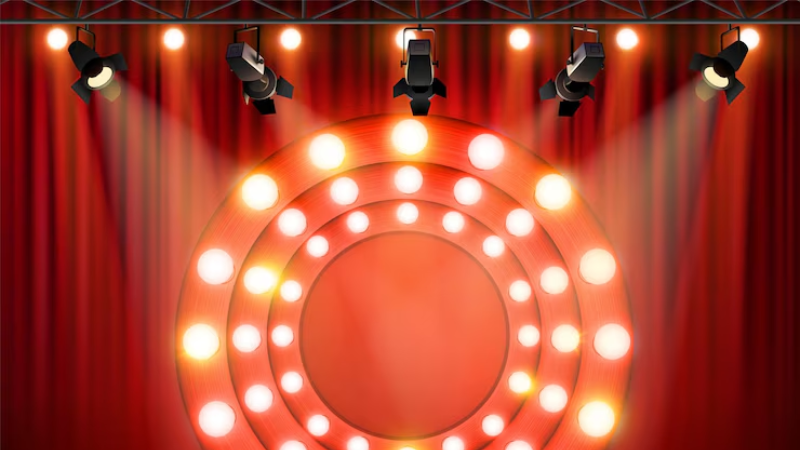
Modern stage design commonly incorporates new technologies for realism and drama:
1. LED Strip Lights and Moving Head Lights
These fixtures are ubiquitous in contemporary theatre, significantly enhancing mood and depth, particularly in dynamic musical and dance productions.
2. Side Lights and Up Lighting
Side lights are vital for defining the lines of performers and scenery, using lateral light to reveal depth and dimension.
Up lighting, typically positioned near the base of walls or objects, is used to highlight dramatic shadows and enhance architectural features.
3. Spotlights
These fixtures are used to pinpoint primary areas or characters, focusing the audience’s attention where the narrative requires it most.
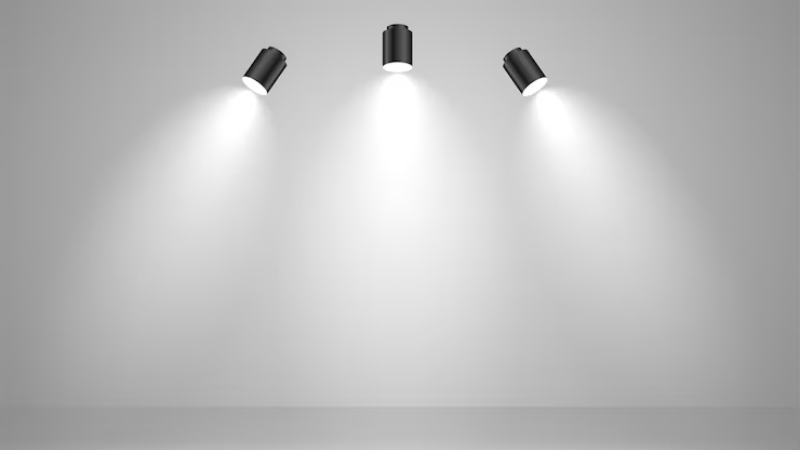
A successful scenic design is the result of multiple elements—including colored lights, custom designs, and highlighting—working in cooperation.
The diverse range of lighting used in theater has specific functions but collectively comprises the visual and emotional landscape of a production and facilitates visibility, definition, and authority of theater in the performance area.

Spotlights are conventional dramatic beams that light up individual actors or sections of the stage. These are separate from “foodlight,” which tracks actors moving across the stage. So, select spotlight vs floodlight with careful consideration.
Ellipsoidal Reflector Spotlights (ERS) are used to create a focused beam of light, and they are best suited for use in situations where precision and control are required.
They are generally applied in stage and theatre productions where sharp edges, well-defined lighting areas, and accurate focus are required.
Their ability to concentrate and throw light so finely enables lighting designers to outline high-intensity highlights on precise performers, props, or areas of a set with little spill.
In return, Fresnel Spotlights create a diffused, soft beam with angular spread and limited beam adjustability.
Although they do not have the pinpoint accuracy of ERS, their broader coverage renders them ideal for general lighting, lighting broad swaths of the stage, or producing ambient light effects.
When employed as backup fixtures in commercial lighting rings, both spotlights make up for the shortcomings of the other.

Wash lights illuminate enormous stage areas evenly. PAR Can Lights provide steady, brilliant light but limited flexibility. Floodlights are available only with electronic control.
Floodlights are used to light large stage areas evenly, and they look across wide angles. Floodlights are also used in outdoor spaces to create a secure and comfortable environment.
Coordinating lighting systems in colour and brightness helps meet various scene needs. It also preserves visual harmony. This method enables steady illumination that aligns with the atmosphere or activity of a scene without overwhelming the focal point.
Designers can create a subtle mood by using equally low lighting in the background and crowd areas. This approach keeps the focus on the main performance without distraction.
Using controlled, even lighting in these spaces ties the visual design together. It makes sure all stage elements support the intended mood and story.
This method works best for complex productions. Background scenery and secondary actors help to create the setting.

Backlighting is a great technique for stage lighting. It adds depth, dimension, and appeal to a performance. When light shines from behind the performers, it creates dramatic silhouettes. This separates them from the background and boosts their visibility and interest.
This separation allows the audience to focus on the performers and their awareness of the stage. Backlighting works well for creating drama. It often sets the mood in scenes with suspense, mystery, or fantasy.
In suspenseful scenes, it creates a spooky atmosphere. In fantasy dramas, it brings a sense of magic. Used subtly or boldly, backlighting defines the emotional tone and visual story of a stage play.
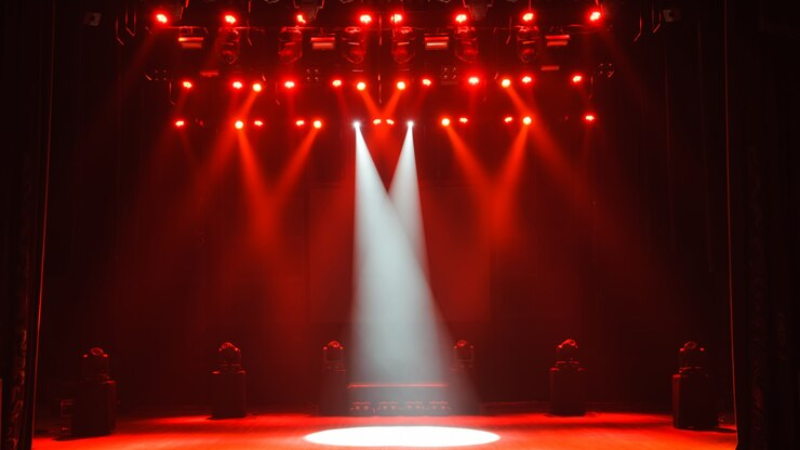
Footlights or downlights avoid unpleasant facial shadows by adjusting the beam shape. While footlights originated in classical theatre and can seem antiquated regarding present-day lighting norms, they remain functionally and aesthetically relevant today in stage production.
They existed from the beginnings of theatre lighting, when they were among the major sources of light, put at the stage front to illuminate actors from beneath. Footlights are selectively utilized nowadays in style or period pieces to create a sense of realism and maintain the historical integrity of the environment.
Footlights not only hold nostalgic value but also provide soft, upward lighting. This creates a warm ambiance that pairs well with other lighting effects.
This old method of lighting design can effectively show the style and character of a setting. So, footlights are an important tool for some uses in the theatre.

These smart lights can be adjusted in direction, colour, and beam angle when in use. Choosing the right beam angle is very important in moving lights.
DMX is controllable, with dynamic beam control and effect, i.e., Gobo projectors. Highly flexible, they are particularly used for dance, concert, and high-energy shows.
Special effects lighting creates striking visual scenes. It includes strobes, UV light, lightning effects, RGB lighting, and smoke sets.
When used with colour gels and Gobos, modern lighting boosts storytelling in visual or supernatural forms.
Metal or glass Gobos sit in front of a light source to cast detailed designs or patterns on stage. They add textures like windows, leaves, or magical symbols. Colour gels help set the mood by adding rich colours that reflect the emotions of a scene.
These tools let lighting designers create immersive spaces that support the story. Whether it’s the eerie light of an alien forest, the glowing charm of a fantasy world, or the sharp contrast in a high-fantasy duel, they are vital.
With their power to shape mood and visual impact, these lighting effects draw viewers deeper into the narrative.
| Light Type | Beam | Use Case | Color Ctrl | Cost |
|---|---|---|---|---|
| Spotlights | Narrow | Focus actor | Manual | Medium |
| Floodlights | Wide | Background | Limited | Low |
| PAR Cans | Fixed | Wash areas | Gel-based | Low |
| Fresnels | Soft edge | Area light | Manual | Medium |
| Ellipsoidals | Sharp | Front light | High | High |
| Moving Heads | Variable | Effects | Digital | High |
| LED Fixtures | Custom | All-round | Full RGB | Medium |
Lighting designers are crucial in shaping a theatre production’s visual and emotional tone. Their work is a sophisticated blend of art and technical expertise.
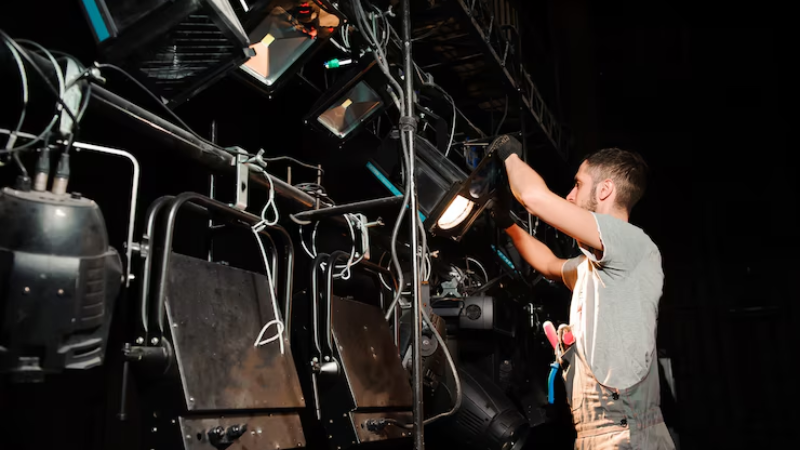
Lighting designers are crucial in shaping a theatre production’s visual and emotional tone, blending artistic vision with technical expertise.
Their core responsibilities involve:
A designer’s keen eye ensures a visually cohesive and smooth performance, with their work greatly enhancing the overall professionalism and effect of a stage show.
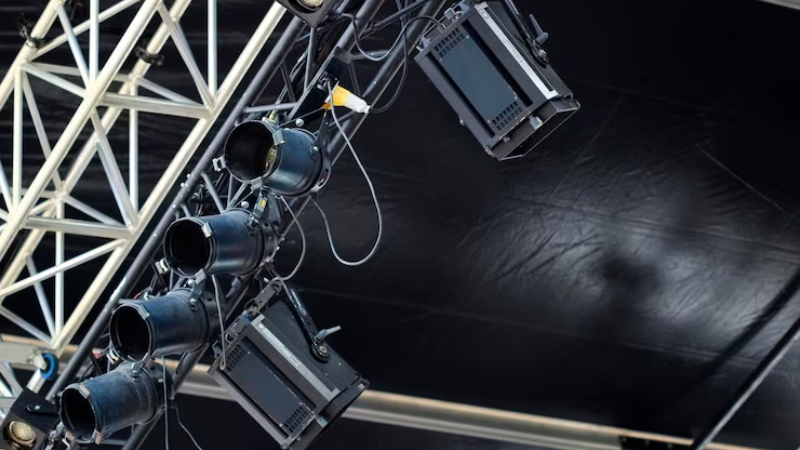
The technology of lighting in theatre has improved significantly thanks to high-tech developments. It now offers better accuracy, better color rendering index, flexibility, and cost efficiency.
Older systems had issues with colour rendering, light quality, and controls. Now, many have been swapped out for smart LED lights and electronic systems. This shift allows for amazing creative freedom.
LED lighting is now the standard in stage lighting. It is energy efficient, produces low heat, and lasts longer. They have set the stage for the latest technologies to be used in theaters.
These lights create unique colour palettes without gels. This allows for quick and uniform scene changes. Program-controlled and motorised lights can change position, shape, colour, and brightness in seconds. They help to enhance the performance on the stage.
The heart of these systems is DMX (Digital Multiplex) technology. This lets designers and technicians control many fixtures from one console. They can sync with actors’ movements, visuals, and sound to create a more rewarding experience.

The hybrid lighting system combines smart LED lighting for great versatility.
Light designers use various methods to blend these systems. They consider the warm colour of incandescent spotlights and the dynamic control and colour movement of moving head LEDs.
Hybrid systems effectively display complex light effects, like rain or sunset. They also add multimedia elements, like projections or interactive graphics. This keeps the artistic flow smooth between different parts of the performance.
Light is what makes an outstanding theatre performance. Light is used to tell a story, give a show its visual rhythm, and bring us together. With the help of new technologies, lighting designs are improving day by day. Achieving the correct light and using it can turn a mediocre show into a legend.
Partner with Risuncorp to get the latest theatre lighting inventory. Explore our full product lineup and discover how we can help bring every scene alive to new heights.
Contact our team today to discuss custom lighting solutions for your event or venue.
Comprehensive Lighting Solutions for MRO Wholesalers and Professionals
send your inquiry
Hi, I'm the author of this post, and I have been in this field for more than 15 years. If you want to wholesale lighting fixtures or lighting related product, feel free to ask me any questions.
Learn More >>Download our catalog to view all of our lighting products.
Ready to get started ?
Send Your InquiryOur team will get back to you promptly

please
download
Get notified about new products
Our team will get back to you promptly!
Add your first comment to this post